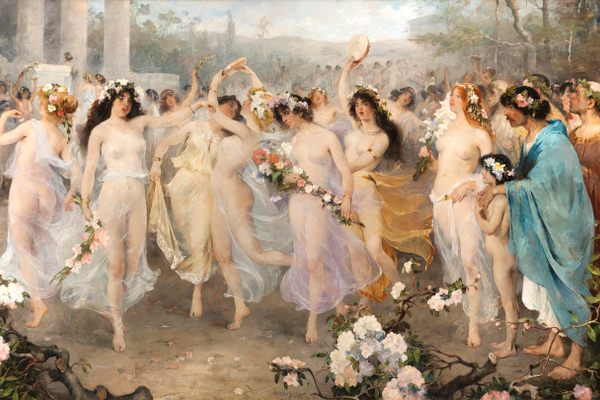How to Tell If You Have Spring Fever
Symptoms include: listlessness and energy, laziness and glee.

Are you feeling tired, or energized? Depressed, or cheerful? Ready to go back to bed, or eager to engage with the world? All answers point to the same diagnosis: spring fever.
Over the last 160 years, spring fever has become an “auto-antonym,” or a word with multiple meanings, one of which is the opposite of another. Back when the phrase first appeared in the U.S. in the 1850s, spring fever meant “the listless feeling caused by the first sudden increase of temperature in spring,” according to one dictionary. The body’s “machinery is clogged,” a writer for the Christian Union wrote in 1878. It wasn’t just a physical ailment, though. The American Agriculturist called spring fever a “feeling of discontent when neither body or mind are at ease.”
By the late 1880s and 1890s, though, Americans’ moralist tendencies were starting to recast this ailment. In 1887, the Therapeutic Gazette sniffed that spring fever was “supposed by many to be moral rather than physical.” A year later, a reader named Josephine wrote to the women’s department of Locomotive Firemen’s Magazine declaring that, “I have decided that I have spring fever. Consequently I don’t propose working very hard.” Common Sense Health Notes described it, in 1893, as “the fever that attacks the boy, causes him to skip school, or shirk work.”
By the early 20th century, spring fever was considered a made-up ailment. “Our grandfathers had much more reverence for spring fever than we have today. In fact they ‘invented’ spring fever,” wrote William Brady, M.D., in a 1916 issue of Illustrated World. The Nurse wrote the next year that, “We admit that one of our medical authorities has recently asserted there is no such thing as spring fever.”

But, according to that very same editorial, “Spring fever is a good kind of fever to have.” Victims included the humming waitress who keeps getting an order wrong, the boy dangling his foot in the lake, a hospital patient who wants his window open, a officer worker who walks three miles every morning instead of taking the streetcar, a usually punctual nurse who comes 30 minutes late—in a car, with flowers. Spring fever had morphed into the opposite of the original ailment: It now meant a light-hearted, carefree feeling. The only symptom the two strains of spring fever had in common was the desire not to work.
“The sufferer sometimes—or in fact quite often—finds it well nigh impossible to resist the temptation to play what in the disciplinary technique of the school is known as ‘hookey,’” wrote the students of St. Mary’s College in Indiana in 1921.
There were cures for spring fever. “On rising, sponge the body lightly and quickly with cold water, briskly toweling after,” instructs the Christian Union. “Rehabilitated, you are now ready for your morning bitters, namely, the clear juice of a fresh lemon in a wineglass of water, without sugar.” In 1893, Common Sense Health Notes advised people to “keep on wearing your flannels,” in order to avoid the disease. In 1916, Dr. Brady advised that, “To stick to your flannels far into the balmy spring is a mistaken way of doing penance.” Many publications advised better diets, spring vegetables in particular. One author had a simple solution: “The best cure of spring fever is to loaf in the sun or go fishing.”
In the 19th century, there were actual diseases that might have affected people in the spring. The season sometimes brought with it cases of malaria, though usually relatively mild. The listlessness may also have been related to the onset of scurvy: Symptoms include feeling “very tired and weak,” as well as “irritable and sad.” (And hence the recommendation to eat vegetables.)
Aside from those medical problems, doctors today associate a rise in energy in spring with hormonal changes. When the day lengthens and the sun comes up earlier, changing levels of melatonin could improve people’s moods and energy levels. Without malaria or scurvy to worry about, spring fever has transformed: Now, if we’re shirking work in spring, it’s not because we’re tired, but because we have too much energy to stay inside.
















Follow us on Twitter to get the latest on the world's hidden wonders.
Like us on Facebook to get the latest on the world's hidden wonders.
Follow us on Twitter Like us on Facebook